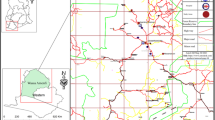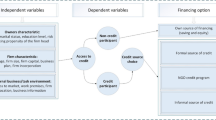Abstract
A study was conducted on small-scale enterprises based on murta (Schumannianthus dichotoma (Sal.) Willd.) in Gowainghat upazila (sub-district) to investigate their nature, profitability and sustainability. The study area was selected purposively while a general random sampling method was followed to select individual respondents. About 94% people are involved in murta-based enterprises and there is a clear division of labour between males and female. Almost 80% of the manufacturing work is done by females. The average annual income of the artisans is Tk.65733 (USD 939) and 62% of the total income comes from murta-based small enterprises. Fresh water swamp forest and homestead forest are the major sources of raw materials and cost of raw materials ranges from Tk.127 for simple dining mats to Tk.188 for coloured bed mats. Net average profit per article ranges from Tk.127 to Tk.250. However, the sustainability of these enterprises is at risk, due in particular to shortage of raw materials and lack of supportive government policy.



Similar content being viewed by others
References
Ahmed QK, Chowdhury FA (1987) Rural Industries in Bangladesh: a syntheses based on studies on rural industries development in selected Thanas. BIDA, Dhaka
Bakht Z (1984) Entrepreneurship in Bangladesh rural industries. Bangladesh Dev Stud XII(1 & 2):25–58
Banik RL (2001) Economic importance and future of Rattan and Patipata in Bangladesh. In: Propagation and Cultivation of Rattan and Patipata in Bangladesh. Roshetko JM, Bose SK (eds). Proceeding of training courses held at the Bangladesh Forest Research Institute (BFRI), Chittagong, Bangladesh, pp 25–28
BBS (1991) Bangladesh Bureau of Statistics, Statistics Division, Ministry of Planning, Dhaka, Bangladesh
BBS (2001) Statistical Yearbook of Bangladesh, Bangladesh Bureau of Statistics, Statistics Division, Ministry of Planning, Government of Bangladesh, Dhaka
BBS (2008) Statistical Yearbook of Bangladesh, Bangladesh Bureau of Statistics, Statistics Division, Ministry of Planning, Government of Bangladesh, Dhaka, 2008
BSCIC (1992) Bangladesh Small and Cottage Industries Corporation, Ministry of Industies, Government of Bangladesh, Dhaka
Chen S, Ravallion M (2007) Absolute poverty measures for the developing world, 1981–2004. Policy Research Working Paper 4211, World Bank, Washington, DC
Choudhury MU (1970) Working plan for the forest of Sylhet division for the period 1963–64 to 1982–83, vol 1. East Pakistan Government Press, Dhaka, p 2151
FAO (1986) Small-scale forest-based processing enterprises. FAO Forestry Paper No. 79, Food and Agriculture Organization of the United Nations, Rome
FAO (1995) National forestry action plan, progress report No. 1 on institutional development. FAO, New Delhi
GOB (1992), Forestry master plan, Ministry of Environment and Forests, Government of Bangladesh, UNDP and FAO. 1992. UNDP/FAO BGD 88/025
Hooker JD (1892) Flora of British India, vol VI. L.Reaves and Co. Ltd, Ashford, Kent, UK, pp 257–258
Mohiuddin M, Rashid MH (1988) Survival and growth of vegetative grown patipata (Schumannianthus dichotoma): an exploratory study. Bangladesh Journal of Forest Science 17(1 & 2):20–25
Prain D (1903) Bengal plants, Vol. II. Bishen Singh and Mahendra Pal Singh, Dehra Dun, India
Rashid MH, Merry SR, Ara R, Mohiuddin M, Alam MJ (1993) How to cultivate Rattan and Patipata (in Bengali). Bulletin 6, Minor Forest Products Series, Bangladesh Forest Research Institute, Chittagong, pp 8–12
Wikipedia (2010) http://en.wikipedia.org/wiki/Schumannianthus_dichotoma. Accessed 16 May, 2010
Acknowledgments
We would like to acknowledge the forestry officials of respective forest ranges for their cooperation in providing necessary information and facilitating field surveys. All the artisans of murta-based enterprises are also acknowledged for their cordial help during the study.
Author information
Authors and Affiliations
Corresponding author
Rights and permissions
About this article
Cite this article
Rahman, M., Das, N.C., Saha, N. et al. Nature, Profitability and Sustainability of Murta (Schumannianthus dichotoma (Sal.) Willd.) Based Small-Scale Enterprises in North-Eastern Bangladesh. Small-scale Forestry 9, 369–378 (2010). https://doi.org/10.1007/s11842-010-9121-3
Accepted:
Published:
Issue Date:
DOI: https://doi.org/10.1007/s11842-010-9121-3




